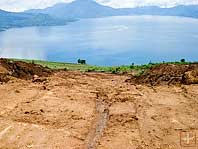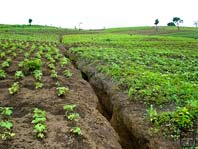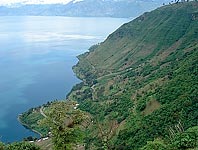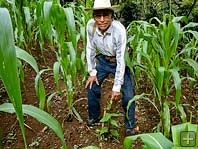Accomplishments in Guatemala
2011 Rain Forest Rescue Report
Through partnership with The Nature Conservancy and local organizations and communities, the following initiatives were made possible last year with support from Rain Forest Rescue.

Local partner Vivamos Mejor identified additional sites and properties for tree planting. Emphasis was on areas affected by Tropical Storm Agatha in May 2010, as well as sites vulnerable to future landslides and heavy rainfall events.
Reforestation of vulnerable lands began in June. According to preliminary data, approximately 102,000 oaks, pines, alders and cypress trees were planted on 237 acres in the Lake Atitlan region. Fifty-three women and 151 men from the municipalities of Nahuala, San Antonio Palopo, San Juan La Laguna, San Lucas Toliman and Santa Lucìa Utatlàn participated. All landowners involved were trained in reforestation techniques and plant maintenance.
Landowners who provide a portion of their properties for reforestation are provided with financial compensation to offset the loss of corn crops that otherwise would have been planted. Funding for these community members is also being sought from Guatemala’s National Forest Institute’s PINPEP program that promotes incentives for small forest landowners. Through this program, participating landowners would receive annual payments per acre of land they have reforested, up to three years. This financial incentive would be welcomed by participating landowners, who despite being impoverished, generously provide their land to restore ecosystem services and protect communities from natural disasters.
Two tree nurseries in the municipalities of Solola and Santiago continue to successfully operate and provided a majority of the trees for last year’s planting projects. A new tree nursery capable of producing 500,000 plants was established in the community of Santa Lucìa Utatlàn by an indigenous community cooperative known as the “Heart of the Forest.” This cooperative has registered their land as a community reserve and operates a hotel and restaurant to generate income. From the new location of this nursery, communities on the upper slopes of the Lake Atitlan region will be more accessible and effectively served by the reforestation project.
Two small tree nurseries established in the municipalities of Sumpango and Patzicia by local partner Sotzil are also productive, with 20,000 plants produced in the Sumpango nursery and 30,000 plants produced in the Patzicia nursery. These trees are both planted in the communities and sold to contribute to the economic sustainability of the nurseries. The Sumpango nursery is managed by a women’s co-operative and Sotzil plans to turn over management of the Patzicia nursery to a similar community group.
Technical and scientific information continues to be gathered to fully understand the hydrology of the region and the key watersheds that support the metropolitan center of the country, Guatemala City. This information will help in identifying the key areas for investment and prioritizing future actions. Informational materials are being produced to inform the public and all stakeholders about the importance of protecting the city’s watersheds and recharge zones. In addition, discussions continue in an effort to form coalitions to study and protect the nation’s waterways.






Save 2,500 square feet of rain forest today
2011 Rain Forest Rescue Report Home Effectiveness of Conservation EffortsOr read and print the full report on one page.
